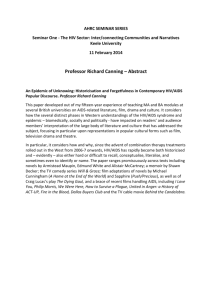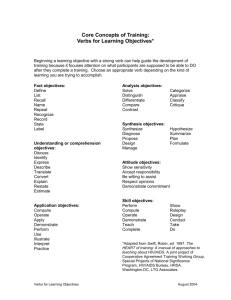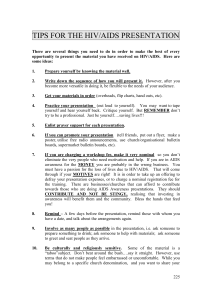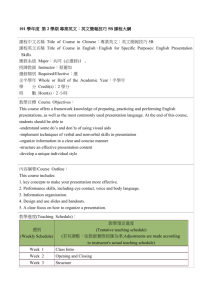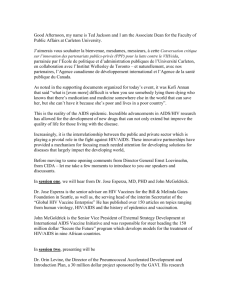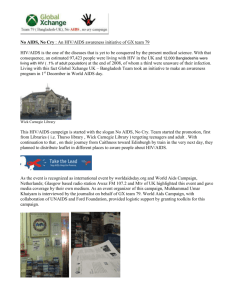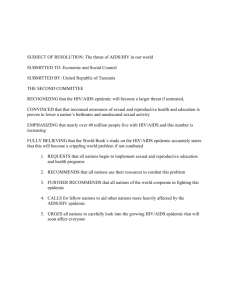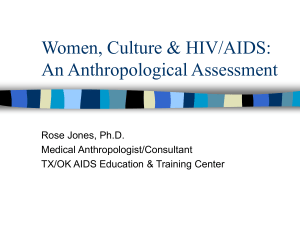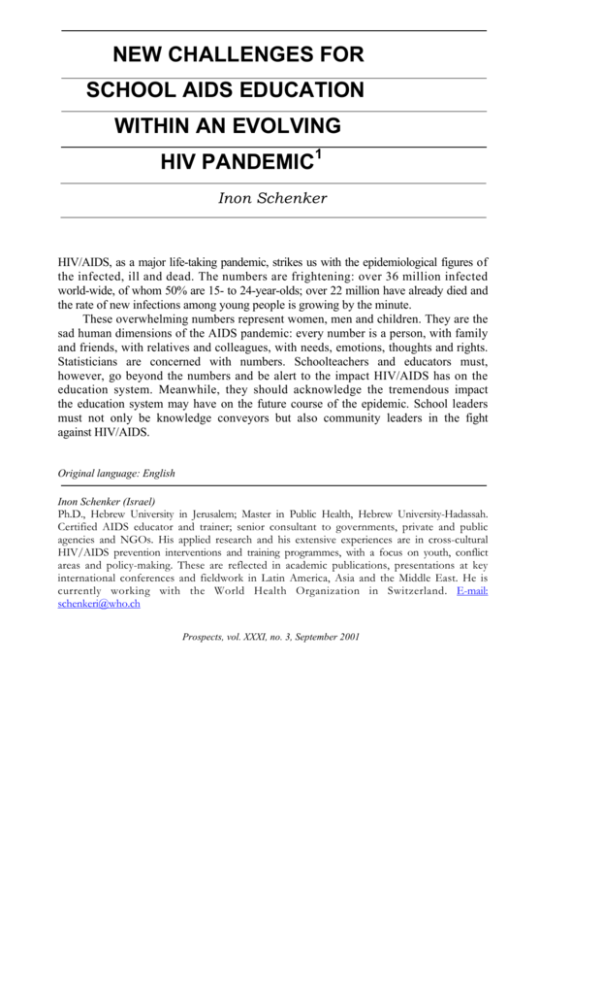
NEW CHALLENGES FOR
SCHOOL AIDS EDUCATION
WITHIN AN EVOLVING
HIV PANDEMIC1
Inon Schenker
HIV/AIDS, as a major life-taking pandemic, strikes us with the epidemiological figures of
the infected, ill and dead. The numbers are frightening: over 36 million infected
world-wide, of whom 50% are 15- to 24-year-olds; over 22 million have already died and
the rate of new infections among young people is growing by the minute.
These overwhelming numbers represent women, men and children. They are the
sad human dimensions of the AIDS pandemic: every number is a person, with family
and friends, with relatives and colleagues, with needs, emotions, thoughts and rights.
Statisticians are concerned with numbers. Schoolteachers and educators must,
however, go beyond the numbers and be alert to the impact HIV/AIDS has on the
education system. Meanwhile, they should acknowledge the tremendous impact
the education system may have on the future course of the epidemic. School leaders
must not only be knowledge conveyors but also community leaders in the fight
against HIV/AIDS.
Original language: English
Inon Schenker (Israel)
Ph.D., Hebrew University in Jerusalem; Master in Public Health, Hebrew University-Hadassah.
Certified AIDS educator and trainer; senior consultant to governments, private and public
agencies and NGOs. His applied research and his extensive experiences are in cross-cultural
HIV/AIDS prevention interventions and training programmes, with a focus on youth, conflict
areas and policy-making. These are reflected in academic publications, presentations at key
international conferences and fieldwork in Latin America, Asia and the Middle East. He is
currently working with the World Health Organization in Switzerland. E-mail:
schenkeri@who.ch
Prospects, vol. XXXI, no. 3, September 2001
416
Inon Schenker
Schools are key contributors to our ability to halt the spread of HIV infection. To
succeed, they must reach children and youth in a timely manner to reinforce positive
health behaviours, while altering risky ones. Schools cover most children between ages of 5-and-18 and have excellent resources for delivering effective education: skilled teachers,
a long-term interactive educational process, various learning opportunities and the
potential of good parent involvement.
`Education about HIV may be most appropriate and effective when carried out
within a comprehensive school health education programme that establishes a
foundation for understanding the relationship between personal behaviour and health'
(CDC, 1988). Nearly fifteen years after this statement was written, its message is still
valid. In combating HIV infection, the crucial responsibility of schools is how to base
HIV-related policies on the most current scientific knowledge about HIV and AIDS,
and to teach young people how to avoid HIV infection or transmission. In doing so,
schools are capable of significantly improving the quality of health education for
youth world-wide.
This paper, therefore, will describe the evolution of school-based HIV prevention
programmes and their theoretical frameworks, as well as present barriers to their
implementation. Examples of several best practices will highlight the key role of the
education sector in mitigating the impact of HIV/AIDS. The paper concludes with an
innovative suggestion for the establishment of a new profession: the AIDS educator.
The evolution of school AIDS education
programmes
Since the mid-1980s, school AIDS education has been evolving from fear-driven and
local to well co-ordinated and transnational. Its content has evolved from information-based to theory-based. Today, the fifth generation of the programme is characterized by three inter-related strategies aimed at reducing the impact of HIV/AIDS on
the education system
1. Effective school health programmes that provide school health policies to
reduce the risks of HIV infection and related discrimination; a healthy, safe and
secure physical and psycho-social environment conducive to risk reduction and
the prevention of discrimination; skill-based health education that enables
students to acquire the knowledge, attitudes, values, life skills and services
needed to avoid HIV infection; and school health services with linkages to
other relevant services to reduce risk and provide HIV-related care,
counselling and support.
Formal and non-formal HIV/AIDS prevention programmes that address sexuality,
reproductive health and substance abuse, especially in schools without effective
health programmes, in areas of high or increasing incidence of infection, and in
settings available to youth who do not attend school.
3 . Co-ordinated school/community HIV/AIDS prevention programmes that increase
access to information, resources and services in forms that are likely to be
Prospects, vol. XXXI, no. 3, September 2001
New challenges for school AIDS education
417
appealing and acceptable to young people (students and non-students)-peer
education, distance learning, anonymous learning and new technologies for
learning.
Education policy-makers and planners must therefore embrace health promotion
activities to achieve their goals. Schools must not only be centres for academic learning,
but also venues for the provision of essential health education and services.
The FRESH approach
A new initiative-Focusing Resources on Effective School Health (FRESH)-was
launched at the World Education Forum in Dakar, Senegal (April 2000). This partnership, sponsored by UNESCO, UNICEF, the World Bank and the World Health
Organization, signals their commitment to help national governments to implement
school-based health programmes in efficient, realistic and result-oriented ways. There is a
core group of cost-effective activities which, implemented together, provide a sound
starting point for intensified and joint actions (Barthes-Hoffman, 2001):
• Clear school health policies on HIV/AIDS discrimination;
• A healthy environment;
• Skill-based education for the prevention of HIV/AIDS;
•
School-based counselling and health clubs for HIV/AIDS.
Expected outcomes are:
•
Delay o f first sex in adolescence. Examples from Senegal (UNAIDS, 2001)
demonstrate that this goal is achievable. Senegalese women in their early 20s
did not have sex until they were almost 19 or older. For their mothers' generation, the median age was closer to 16.
•
Encourage abstinence. In Uganda, the proportion of 15-year-old boys or girls
reporting that they had never had sex rose from around 20% to around 50%
from 1989 to 1995 (ibid.).
• Promote condom use. The `100 % Condom Use' campaign in Thailand (ibid. )
resulted in a drop of 90% in `non-use' of condoms among young people.
School AIDS education: theories
An artificial separation of frequently used theories about behavioural changes is as
follows (UNAIDS, 1999a):
• Theories that focus on the individual's psycho-social processes;
• Theories that emphasize social relationships;
•
Theories discussing structural factors explaining human behaviours.
A summary of these theories can be found in Life skills approach to child and adolescent
health development (Mangrulkar et al., 2001) and a recent review by UNAIDS (1999b).
They include: social learning theory (Bandura, 197 7, 1994); health belief model
(Becker, 1974); problem-behaviour theory (lessor & lessor, 1977); social influence
theory ;Howard & McCabe, 1990); multiple intelligences theory (Gardner, 1993);
resiliency and risk theory (Luthar, Cicchetti & Becker, 2000) among others
Prospects, vol. XXXI, no. 3, September 2001
(Ajzen & Fishbein, 1980; Prochaska et al., 1994; Rogers, 1983; Fisher & Fisher,
1993).
School AIDS education: effective practices
The vast experience gained internationally over the last decade and a half in developing and
implementing interventions and programmes to educate schoolchildren on HIV prevention
has yielded a well-established set of at least twelve essential considerations.
PARTICIPATORY AND SKILL-BASED
For education on HIV prevention to achieve its goals, teaching methods must evolve
from ordinary teaching, in which teachers lecture to their students, to participatory
methods, in which students play an active role in the learning processes. Teachers, in
the same way as pupils, need to realize that AIDS classes are different. Participatory
methods in education are the key to moving from information-based programmes to
skill-based ones.
The set of skills for HIV prevention has been under debate for several years, and
is value-based. When assessing the essential HIV prevention skills that should be
taught and practised in every school the following are recommended: communication
skills, value clarification, decision making, negotiation, goal setting, self-assertion and
stress management skills.
In conservative communities, there is wide acceptance of the notion that condomuse
skills are absolutely unnecessary, while in most other communities these skills are
regarded as essential. This is just one example of our need to develop culturally
appropriate interventions that would gain wide acceptance.
WELL-TRAINED HIV/AIDS PREVENTION EDUCATORS
HIV prevention and anti-discrimination are complex issues. They demand welltrained, experienced educators with particular characteristics that may allow them to
be effective behaviour-change agents in schools. Not every schoolteacher is a
`good' school AIDS educator. In recent years various groups have promoted peer
AIDS education, based on selected high-school students, trained to provide AIDS
education to their schoolmates. Little consideration, however, is given to the characteristics of schoolteachers or peer educators.
Four key virtues of an effective AIDS educator, as desired by students, were
reported (Schenker & Greenblatt, 1993): wealth of knowledge about HIV/AIDS,
openness, sincerity and a sense of humour. These examples highlight two key elements in
the preparation of effective AIDS educators: first, the need to pre-select them
according to criteria that have yet to be defined; and second, the severe lack of preand
in-service training.
Human resources are central to capacity building for school AIDS education
world-wide. There are plenty of examples demonstrating the enormous influence a
Prospects, vol. XXXI, no. 3, September 2001
few well-trained and capable individuals can have on large student populations
(Schenker et al., 1998, Kirby, 1995). The training of AIDS educators can begin
during teacher training, and is followed up by in-service training for sub-populations
within the education sector (e.g. curriculum developers, senior policy makers,
inspectors).
DISCUSS CONTROVERSIAL ISSUES
Teaching HIV prevention and anti-discrimination in school presents several challenges to every educator. A primary one has to do with the ability to discuss controversial issues openly with pupils in class. Educators who feel comfortable with their
sexuality, adhere to human rights values and respect their students are better at
discussing important controversial issues related to HIV/AIDS in class, such as disclosure
of HIV status, pre-marital sex and homosexuality, (Janz & Zimmerman, 1996; Basch,
1989). Crosby (1996) adds that development of an open and honest atmosphere and
a caring relationship between teacher and students is critical.
PROVIDE MULTIPLE SESSIONS THROUGH MULTIPLE MEDIA
For school-based AIDS education to be effective, it must not be based on a quickfix
approach. Successful programmes suggest that at least four class sessions should be
essential for achieving a minimal effect on students' knowledge, attitudes and
behaviour-change intentions; ten to fourteen sessions are better.
Classes on HIV/AIDS should be different. Employing multiple media (e.g. stories,
role-play, lectures, self-tests) provides an opportunity for engaging students actively in
the learning process (Ragon et al., 1995). Effective repetition of basic AIDS messages requires
clarity, consistency and sufficient variety to hold learners' interest over time. Cooperative learning also provides an opportunity for active learner
participation, enhancement of social skills, increased retention and enjoyable learning.
Haffner (1996) asserts that AIDS education should not be the responsibility of
any single sector of the community. Designing local programmes should involve
parents, community opinion and local religious leaders, teachers, school administrators, community and youth agencies, health organizations and the adolescents
themselves to ensure that it is culturally relevant and consistent with religious and
social values (Siegel et al., 1996).
Soliciting participant involvement into all phases of the AIDS prevention intervention supports its marketability, enhances its credibility and helps participant
learning and behaviour change. The parent community could also participate. Parents' selfefficacy as sexuality/AIDS educators for their children can be enhanced if schools involve
them during AIDS education activities, while teachers should provide parents with
guidelines for home discussions on health topics.
In addition, positive, non-judgemental attitudes on the part of school personnel,
using a combination of communication strategies, are essential in maintaining parent
involvement in school activities (Hahn et al., 1996).
Prospects, vol. XXXI, no. 3, September 2001
RELEVANCE TO ALL PUPILS
As a sexually transmitted disease, HIV should be taught in contexts that are
gender-sensitive and gender-appropriate, taking into account the fact that more
than 75% of infections world-wide are due to unprotected heterosexual
intercourse. Schools will often provide separate sex education classes to boys and
girls. This should not be encouraged in HIV/AIDS education. Recent studies
provide very little evidence to support the contention that sexual health and HIV
education promote promiscuity. Of sixty-eight reviewed reports, twenty seven
reported that HIV and sexual health education neither increased nor decreased
sexual activity, while twenty-two showed a delay in the onset of sexual activity, a
reduced number of sexual partners or reduced unplanned pregnancies and sexually
transmitted infection rates (Grunseit et al., 1997). Teaching HIV prevention to
boys and girls should encourage them to talk about HIV and sexuality among
themselves.
CULTURALLY SPECIFIC AND LINGUISTICALLY APPROPRIATE
Prevention efforts should consider community norms and sensitivities. Working
closely with the target group of young people and key elements from the community
during development, planning, implementation, evaluation and redesigning of a
school-based AIDS education curriculum provides an opportunity for them to
assume ownership of the problem and solutions to it (Levy et al., 1995). In addition,
paying attention to the norms, values and traditions of the target population will
allow for wider dissemination of the messages. It is advisable to combine vernacular with
formal terminology to ensure understanding of important concepts in HIV prevention,
support and counselling.
SOCIAL AND PEER INFLUENCES AND PRESSURES
From a survey of thirty-seven projects on successful approaches and barriers to AIDS
prevention programmes in the United States, Janz and Zimmerman (1996) report
that providing unique forums for open discussions of health-promoting information
increases group norms supportive of safer sex and diminishes drug use behaviours.
Open discussions give participants increased control and may reduce pluralistic
ignorance (the belief that one is alone in one's beliefs or experiences). It was shown
that teachers are able to create a safe physical space for children and adolescents to
engage in candid discussions. Unlike mere lecturing, open discussions get children
involved (O'Hara et al., 1996).
REINFORCING BEHAVIOUR AGAINST UNPROTECTED SEXUAL BEHAVIOUR
Group norms and behaviours are key factors in adolescents' development.
The contribution of the social environment in supporting healthier behaviour represents
a key component in maintaining that behaviour.
Group pressure can effectively support
Prospects, vol. XXXI, no. 3, September 2001
New challenges for school AIDS education
421
an individual's decision to act in a given way, and group support is necessary to
reinforce responsible actions (Basch, 1989).
By using social influence approaches (O'Hara et al., 1996), a social consensus
model, peer education and small-group discussions (Cenelli et al., 1994; Janz &
Zimmerman, 1996) desirable group values can be achieved. Given the nature of HIV and
the controversy surrounding its discussion, targeted interventions could be
complemented by reaching out to a wider audience than those considered at risk, and
changing the social consensus of the larger communities in which youth are
embedded.
LINKAGES WITH PARENTS, HEALTH AND COMMUNITY SERVICES
The `triangular model', developed as part of the `Immune System Approach to AIDS
Prevention' (ISYAP), provides an important assertion (Schenker, 1988 ): schoolbased AIDS education should focus on the pupils at school, but in close linkages
with their parents and the community at large. These linkages will strengthen, on the
one hand, the protective influences on the young people, coming from both school
and home, and on the other better inform parents of HIV infection and its
prevention.
The need to strengthen the links between the education and health sectors is
best presented in the FRESH approach (B arthes -Hoffman, 2001).
TEACH LIFE SKILLS AS A COMPONENT OF A SKILL-BASED APPROACH
In addition to imparting accurate information and knowledge, and dispelling AIDS
fears and misconceptions, the theoretical frameworks developed in recent years
emphasize what several authors had already identified at the beginning of the 1990s
(Bosworth & Jadara, 1993): AIDS education curricula should provide learners with
problem-solving skills, decision-making skills, and communication, refusal and negotiating skills, as well as skills helping them avoid alcohol and drug use. Ogletree et al.
(1995) suggested that published AIDS education curricula in the United States have
increasingly focused on building general personal and social skills, though specific
skills, such as conflict management and refusal skills, still need greater attention.
Developing self-efficacy may help individuals to act on their motivation (Ashworth et al.,
1992).
INTEGRATION WITHIN COMPREHENSIVE HEALTH EDUCATION
Integrating AIDS education as part of a comprehensive health education programme that
begins in the early years of elementary school and continues until high school has
been favoured (Maier et al., 1992; Ogletree et al., 1995). Several other authors affirm
that success of HIV/AIDS prevention programmes is possible when AIDS education is
comprehensive and integrated with other risk reduction issues (such as drugs and
sexuality) and with anti-discrimination (O'Hara et al., 1996; Zaccone-Tzannetakis,
1995).
Prospects, vol. XXXI, no. 3, September 2001
PEER COUNSELLING AND PEER SUPPORT
Peer education has been cited as a most promising strategy for delivering AIDS education
to children and adolescents (Cenelli et al., 1994; Siegel et al, 1996). Trained peer
educators serve as role models in reducing misconceptions about HIV risk and for
initiating communication about protective behaviour. Peer educators can be effective
messengers of AIDS education and effectively contribute to AIDS awareness in the
school population (Arnold, 1995), provided that they are carefully selected and properly
trained. This approach still needs to be properly evaluated.
Barriers to skill-based AIDS education in schools
The elements distinguishing school-based programmes from other interventions for
youth are clearly the supportive structural aspects played by schools and teachers,
and the interaction between school, parents, pupils and the community at large.
However, AIDS education in school is often denied to children and young people
because of barriers that are identified at three levels: the community level, the organizational level and the psychological level. At the community level, the following
barriers have been identified:
DENIAL OF THE HIV/AIDS PROBLEM
The infection rates of HIV in the most-affected countries make it impossible not to
recognize its enormous effects on the community. Nevertheless, denial of HIV/AIDS as a
problem prevails among communities and leaders in these countries. In countries
less affected by the current wave of the HIV/AIDS pandemic, it receives
low priority on national agendas.
Schools do not exist in isolation. Community attitudes make their way into
policy-making processes, both in the individual school and at the national education
system level. In societies where there is denial of HIV/AIDS as a public health problem,
schools find little support in developing policies on prevention.
The social environment is also the repository of social meanings and norms for
behaviour, including the behaviours relevant to avoiding health risks (Mann et al,
1988). However, if the socially shared values of the community are in conflict with
the principal messages of HIV/AIDS prevention, there may be a strong barrier to
delivering AIDS education in schools. Basic discrepancies between the beliefs and
opinions of decision-makers and the epidemiological and social realities of a
country may constitute important barriers to the implementation of effective
preventive campaigns.
AIDS IS A HEALTH SECTOR RESPONSIBILITY
The initial conception that HIV/AIDS is a health sector issue hampered the education
sector's response. Ministries of education and other sectors of society felt less urgency
in responding to the epidemic, arising partly out of early erroneous expectations
Prospects, vol. XXXI, no. 3, September 2001
New challenges for school AIDS education
423
that, although catastrophic, the disease would spread much more slowly than has
in fact been the case. Likewise, for many governments, responding to security needs
received higher priority than dealing with the pandemic.
NEGATIVE PARENTAL ATTITUDES
Varying from country to country, parents have a lot to say about the education of
their children. Organized structures (e.g. parent/teacher associations, governing
bodies, parents' briefings) allow parents to influence the content, structure and length of
the education their children receive at primary and secondary schools. Involving
parents in the process of development, implementation and monitoring of schoolbased AIDS education may be a good strategy to diminish or manage potential
conflicts with parents (Schenker & Yechezkiyahu, 1991). Unfortunately, this strategy
is seldom used (Haignere et al., 1996; Schenker & Greenblatt, 1993).
ABSENCE OF A HIV/AIDS EDUCATION POLICY FOR SCHOOLS
When a clear, binding, evidence-based and culturally appropriate policy on schoolbased AIDS education is developed, schools receive enormous support in implementing effective programmes.
In the early years of the epidemic, model policies were unavailable. For example,
in an assessment of 232 American School Health Association members, Kerr,
Allensworth and Gayle (1989) showed that 71 % of the respondents reported a need for
model policies on appropriate levels of AIDS education within school settings, while
66% indicated a need for model policies on confidentiality relating to the HIV status of
students. Since then, wide ranges of policies have been developed internationally
(Closen, Sy & Schenker, 1995; WHO, 1992; UNAIDS, 1999b), nationally (CDC,
1988,) and locally. Yet, there is a gap between policies and implementation, especially
adaptation to the evolving facets of the epidemic. In many developing countries,
however, there are still no policies at all.
Within schools, questions remain unanswered as to whose responsibility it is to
teach about AIDS. Where in the school curricula should the topic be taught? And how
will schools recognize, assist and support teachers' commitment to preventing
HIV/AIDS through education?
A clear understanding as to who (if at all) in the school community should
know that a child is infected with HIV deserves more attention (Ballard et al., 1990).
Some 20% of the respondents in a pre-service teachers' population stated that no
one should know; 30% felt all school personnel should know. One-half of respondents suggested that only the principal, nurse and teacher need to be informed.
LACK OF PRE-SERVICE AND IN-SERVICE HIV/AIDS TEACHER TRAINING
The emergence of school programmes on HIV/AIDS was not planned. In many cases
individual, often local, initiatives started the `snowball' process of national action.
Thus, many teachers are not prepared to teach HIV/AIDS prevention in the
recommended
Prospects, vol. XXXI, no. 3, September 2001
context of school health education or as a topic in human sexuality. The simple
reason is that this subject, as well as active teaching methods necessary for effective
behavioural education, is not included in the curricula of most teacher-training
colleges (Haignere et al., 1996). The authors suggest that lack of materials and lack of
time, as well as difficulty in adapting traditional classroom structures, are creating
barriers to using alternative teaching strategies, such as role play and small-group
discussions. This leads to differences in the quality of teaching among teachers in the
same town, or even in the same school (Siegel et al., 1994; Gingiss & Basen-Engquist,
1994).
This perceived lack of knowledge, skills and self-confidence among teachers
hinders effective delivery of AIDS instruction in the classroom (Ballard et al., 1990).
Teachers cannot be expected to adapt well to new roles without adequate training and
time for practice and reflection, which too often is not available (Basch, 1989). High
rates of teacher and administrative turn-over, reassignments, competition from other
lessons, lack of teachers' commitment and reluctance of less innovative teachers are
other barriers (Gingiss & Basen-Engquist, 1994). This striking factor has only
recently been addressed through a collaborative effort by Education International and
several United Nations agencies, aimed at providing new dimensions to teacher training
in facilitating skill-based AIDS education in schools (Strickland, 2000).
LACK OF PROPER AGE-APPROPRIATE CURRICULA
In most countries, we note a process in which curricula were first developed for highschool students, followed by modifications to meet the needs of younger pupils, outofschool youth and, lately, students with special needs. Only a few examples exist (e.g.
Uganda, Israel) in which the direction was upward from the start: age-appropriate
curriculum development from primary to secondary schools to university level.
Reviews of current school curricula in various countries merit the following
observations (DiClemente et al., 1993; Van Oost et al., 1994; Gingiss, 1992; Holtzman et
al., 1992; Aggleton et al., 1989; UNAIDS, 1997).
• Curricula are often not developed to be appropriate for the intended student
audience.
• Many existing school-based HIV-prevention programmes offer brief interventions
that may not be sufficient to motivate adolescents to adopt HIV-preventive
behaviours, particularly among younger adolescents.
• Teachers tend to devote a considerable amount of time to providing basic information on sex and drugs education, rather than on preventing AIDS.
• Critical risk reduction skills for young people when they may most be needed are
often not addressed.
•
School-based HIV-prevention lessons that emphasize didactic instruction may
severely restrict interaction among students. Most teachers prefer verbal teaching
methods (recitation, lecturing) to active, participatory teaching techniques, such
as role play and group work, which are important for securing attitude and
behaviour change.
Prospects, vol. XXXI, no. 3, September 2001
New challenges for school AIDS education
•
•
•
•
•
At
425
Not enough time is dedicated to exploring peer pressure, and practising resistance and refusal skills.
Most teachers providing AIDS education are self-taught and use self-developed
teaching materials owing to lack of resources.
Lack of standardized AIDS education curricula may result in education of
unstable quality and quantity.
International guidelines and modules are not disseminated globally, owing to
either a lack of dissemination strategies or a lack of funds to translate good
materials into other languages.
The preparation of materials, modules and exercises does not follow basic rules in
developing health education materials (e.g. focus groups, pre-test, needs
assessment).
the psychological level the following barriers have been identified:
TEACHERS' FEARS
Teaching AIDS prevention is a tough job. It demands excellent and updated knowledge
of the specifics of immunology, behaviour change, epidemiology and clinical aspects.
It also asks one to look into one's own beliefs, attitudes, conceptions (and
misconceptions) and sexual behaviours, substance (ab)use, human rights concerns
and inter-personal relationships. For many teachers this is too demanding.
Surveys of teachers' attitudes reported a lack of comfort discussing homosexuality,
bisexuality, death and partner communication about AIDS, correct condom use and explicit
sexual behaviours (Haignere et al., 1996; Kerr, Allensworth & Gayle, 1989).
For others, there is a simple fear of HIV/AIDS. Ballard et al. (1990) surveyed preservice elementary teachers' opinions about school-related HIV/AIDS issues. The
authors found that 44% of their respondents indicated they were afraid to think that they
would one day have a student with AIDS in their class; 30 % indicated that they would
feel personally threatened by such a situation. One-fifth indicated that they should
have the right to refuse to have a child with AIDS in their classroom. Strouse and
Phillips (1987) affirmed that teachers have refused to instruct HIVinfected students.
While these reports come from less affected countries, they alert us to the need to
study, think of and appropriately address the fears of teachers in many countries when
trying to overcome existing barriers to the implementation of effective prevention
programmes in school.
FALSE SENSE OF SECURITY
HIV/AIDS is a latent disease. Because of the long incubation period, infected individuals continue to function and appear healthy for many years before succumbing to
the disease. This creates a false sense of security. As AIDS became a chronic disease,
its impact was diluted by detrimental effects being experienced in piecemeal fashion.
Only lately has the cumulative effect of this steady, constant erosion of human
resources drawn attention to the urgent need for national action.
Prospects, vol. XXXI, no. 3, September 2001
LIFE SKILLS AS PART OF SKILL-BASED AIDS EDUCATION
In preparing students for the twenty-first century, schools cannot simply equip pupils
with basic literacy and numeracy. More advanced skills are required. Skills for living are
critical, particularly in regions where no one but schoolteachers can convey them in a
meaningful way.
Based on research and on theories of human development, three key skill categories were identified (Vince Whitman et al., 2001):
•
Social or interpersonal skills;
•
Cognitive skills;
•
Emotional coping skills.
These skills may be used simultaneously. The interplay between them is what
hopefully produces powerful behavioural outcomes. In HIV/AIDS/STI prevention,
these skills may be further refined. Within the social skills domain, we may
include:
• Communication skills: effectively expressing a desire to delay the initiation of
intercourse; influence others to practise safer sexual behaviours and to prevent
discrimination against HIV/AIDS victims.
•
Negotiation/refusal skills: refusing sexual intercourse or negotiating the use of
condoms.
•
Interpersonal skills: be caring and compassionate when interacting with someone
who is infected; practise healthy dating and relationships.
Within the cognitive skills domain the following skills may need to be addressed:
•
Decision-making skills: seek and find reliable sources of information about
sexual anatomy, puberty, conception and pregnancy, sexually
transmitted diseases, HIV/AIDS, local prevalence rates, alternative
methods of birth control; analyse a variety of potential sexual situations
and determine a variety of actions that may be taken and the consequences
of such actions.
• Critical thinking skills: analyse myths and misconceptions about HIV/AIDS,
gender roles and body image perpetuated by the media; analyse social influences
regarding sexual behaviours.
Within the emotional coping skills we may wish to include:
•
Managing stress;
•
Seeking services to help with sexual issues, such as unplanned pregnancy;
•
Increasing internal locus of control;
•
Establishing a personal value system that is independent of peer
influence.
The debate on what `life skills' mean in practice is not over. There are
several sets of proposed skills defined by various stakeholders. What is
essential is to note that skill-based school AIDS education is a must for programmes
to achieve their goals. There is an urgent need to develop curricula that will
include an agreed (locally) set of skills, which pupils should know and practise.
Prospects, vol. XXXI, no. 3, September 2001
New challenges for school AIDS education
427
Several national examples
Given the absence of a vaccine and the inability of medical science today to contain the
AIDS virus, education is one of the most effective ways to combat the pandemic. It is
unanimously recognized that education has a key role to play, not only as a means of
passing information, but also as a means of changing attitudes and behaviour
concerning AIDS, both as a disease and as a social phenomenon. In exchanging information on best practices, Member States of UNESCO are able to learn from each
other.
UGANDA
Uganda may serve as a very good example of a country where political commitment at
the highest level was translated into action-yielding results. HIV infections in Uganda
are declining. In one site in Kampala, the HIV prevalence rate among urban pregnant
women, aged 15-19, was 29.5% in 1992. It declined to 14-10% in 1996 and
stagnated thereafter (Malinga, 2000). An increase in the age of first sex, a reduction in
the number of casual sex partners and an increase in general condom use, especially
between casual sex partners, were documented in surveys conducted by the Ministry
of Health. This less risky behaviour among young people may well be correlated with
the responses to the epidemic by the education sector in Uganda dating back to
1986.
Uganda was one of the twelve first countries to implement a comprehensive
school AIDS education. In 1986, the Ministry of Education launched a major campaign
(SHEP) that included the development of school curricula for primary and secondary
schools, seminars, training workshops for teachers, AIDS drama shows and, above all,
the inclusion of HIV prevention education into national policy-making. Two
educational programmes on HIV/AIDS in Uganda gained wide publicity:
Straight talk is a widely distributed newsletter, targeting secondary school
students (15-19), as well as young adults in colleges and universities (20-24). It
advocates safer sex, including abstinence, masturbation, non-penetrative sex and
condom use. Its counterpart for younger people, Young talk, is aimed at upper
primary school pupils and young adolescents aged 10-14. In primary schools, teachers
are encouraged to use Young talk as a teaching tool. An evaluation in 1995 found that
that 8 % of the 1,682 adolescents surveyed cited Straight talk as their main source of
information on HIV. (Radio was ranked first at 43%.)
Madarasa AIDS Education and Prevention Project (MAEP) was implemented
by the Islamic Medical Association of Uganda (IMAU) and UNICEF. Its objectives ar°
to provide HIV/AIDS education to young people in Muslim religious schools and to
teach young people both to empathize with persons living with HIV/AIDS
(PLWHAs) and to help victims in their own. communities. MAEP works with 350
Madarasa schools, informal schools attached to mosques that teach young people up
to 15 years of age Islamic culture and behaviour. Madarasa teachers are Imams
Prospects, vol. XXXI, no. 3, September 2001
428
Inon Schenker
or Assistant Imams, and some are members of the Uganda Muslim Teachers'
Association. Classes include in-school as well as out-of-school children. They are
taught how to care for HIV/AIDS patients and are encouraged to help them in their
own communities. Parents and guardians are encouraged to talk to their children
about HIV/AIDS. The curriculum includes the following subjects: understanding
adolescence; adolescent friendships; peer pressure; understanding sexuality; facts and
myths about HIV/AIDS; Islamic teachings on safe sex; responsible healthy living;
breaking the stigma; peer counselling; building positive dreams; and discussing
HIV/AIDS with parents. IMAU gives training in the use of the HIV/AIDS education
curriculum to Imams in each district. Overall, 20,000 Muslim children have been
given HIV/AIDS education in Madarasa schools since 1995.
ISRAEL
Israel was also one of the first countries to introduce a comprehensive AIDS education
programme into its school system, starting in 1986 with primary schools and scaling
up to university and non-formal education. It is now ranked among the lowest
on the scale of HIV incidence and prevalence, with fewer than 100 new reported
cases a year.
The Jerusalem AIDS Project (JAIP) is a volunteer-based, national and international
NGO. In Israel, since its inception in 1987, JAIP has specialized in school-based AIDS
education, developing two curricula for elementary and high schools. It has also initiated
peer AIDS education programmes in which medical students are trained as AIDS
educators for schoolchildren and out-of-school youth. These programmes make use of selfcontained and self-explanatory AIDS educational kits, which are based on the Immune
System Approach (ISYAP) Model (Schenker et al., 1998; WHO, 1987). JAIP also
conducts five-day workshops for teachers, physicians and nurses. So far over 3,000 people
in Israel have been trained as AIDS educators by JAIP. JAIP has also been involved
in AIDS education training projects in twenty-five countries of Asia, Eastern Europe,
Latin America, Africa and the Middle East (Erbstein, Greenblatt & Schenker, 1996).
This unique feature of an NGO with a strong local/national arm and, at the s ime
time, a second strong international arm created vast opportunities for experimenting
with cross-cultural transfer of HIV/AIDS messages, campaigns and school curricula. It is
estimated that more than 600,000 pupils have been taught to date by the modules
developed by JAIP, based on the ISYAP approach.
In 1995 JAIP initiated a Middle East regional project which promoted the
establishment and on-going functions of a regional network of AIDS educators from the
Middle East countries. Remarkably, the participants came from communities hostile
to each other. JAIP has demonstrated that the common combat against HIV/AIDS
can be a bridge for peace (Schenker et al., 1998).
THAILAND
The decline of HIV infections in Thailand represents a major national achievement.
prevalence rates in 1995 were 34.91 per 100,000 and in 1999 they were 29.84. New
Prospects, vol. XXXI, no. 3, September 2001
New challenges for school AIDS education
429
infections were reduced each year in Thailand from almost 143,000 in 1991 to
29,000 in 2000 (Thai Working Group, 2000). It is notable that in Thailand there is
active involvement by every level concerned: government, academic institutions,
NGOs, the private sector and families as well as individuals (Cleesuntorn, 2000).
The multi-sector and multi-disciplinary strategy to raise awareness was further
complemented by high-level co-ordination (prime minister level), the
formation of extensive networks to reach every community and a special budget
allocation for HIV/AIDS prevention activities.
The early recognition of AIDS as a national problem has enabled Thailand to
respond to it effectively. HIV/AIDS education was integrated into the national curriculum
at all levels as early as in 1987.
As the epidemic evolved, so did the approaches used to tackle it within the
school system. At first, HIV education was introduced as a single subject within
health education classes. This was followed by content to develop more responsible
attitudes and behaviours. Later on came the application of real-life issues and a greater
emphasis on sex education. In recent years, a new concept was introduced into the
curricula: `living with HIV/AIDS'.
To strengthen efforts by the education system, co-ordinated campaigns were
launched involving the mass media, non-formal education, indigenous learning
networks and the national training of community leaders and government officials.
CANADA
Skills for Healthy Relationships (SHR) is a curriculum providing AIDS education and
prevention for junior-high school students. Initiated in 1990, it aims at delaying
sexual activity, increasing protective measures taken by sexually active youth, creating
compassion for persons living with HIV/AIDS (PLWHAs), improving communications and
negotiating skills, and combating homophobia. It is funded by Health Canada and the
Council of Ministers of Education. The curriculum was designed to meet the needs of
Grade 9 students (mostly 14-year-olds) and fit with the curriculum objectives for this
grade level.
Workshops for teachers to introduce the curriculum were provided. Funding was
provided to the Northwest Territories Association for School Health to develop a
specific aboriginal adaptation of the curriculum.
The programme also included a two-phase evaluation. The implementation
evaluation comprised feasibility assessment and implementation monitoring. The
impact evaluation sought the stakeholders' reactions to the programme through
focus groups, interviews and questionnaires. The outcomes evaluation assessed not
only outcome behaviours but also the extent to which factors such as relevant
attitudes, knowledge and motivational supports and skills enabled students to act in a
health-conscious manner.
An evaluation of the project indicated that the SHR programme was very well
received by participants (students, teachers, parents, administrators). Two years after
participating in the programme, a majority of the demonstration group students
Prospects, vol. XXXI, no. September 2001
430
Inon Schenker
reported that they had gained in assertiveness, compassion, confidence and comfort in
talking about condoms and personal rights.
A new profession: HIV/AIDS educator
A new concept in developing human resources is required in order to handle the
crises of HIV/AIDS. I would like to suggest that education systems rethink about
engaging ordinary schoolteachers in teaching about HIV prevention and anti-discrimination. Teachers, when properly trained and provided with the appropriate materials,
are able to conduct effective skill-based AIDS education, but their other responsibilities
might distract their work. In scaling up our fight against HIV/AIDS, we need a
specialized group of `AIDS educators', whose only task will be to ensure 100%
coverage of schoolchildren and young adults with AIDS education. The `squad concept'
may be helpful in systematically reaching that goal. Teams of `AIDS educators' will
assume responsibility for covering, one by one, schools in rural and urban areas, using
a pre-tested, culturally appropriate and well-defined curriculum, over an effective
period of time that will allow knowledge acquisition and behavioural change in the
target population.
The `AIDS educators squad' can be composed of schoolteachers and people
from other professions (e.g. social work, nursing, public health). We may even wish to
consider using well-selected and trained medical students to perform this task. This
concept may be challenged by the following questions:
•
Who will train AIDS educators? How?
•
What kind of rapport will they have with the pupils, being outsiders to the
school?
•
Will a new structure be needed for co-ordinating this effort, or could existing
structures be used?
•
What will be the incentive for the new profession? Why should it be supported?
•
Is this going to be cost-effective in comparison with teacher-based
approaches?
•
What effect will the development of the profession have on the new approaches for
strengthening skill-based and life skills education? Can it complement and
strengthen these efforts?
This discussion is beyond the scope of this paper. The International Conference on
Education (September 2001) may be a first platform to debate this concept, within the
framework of living together in the twenty-first century.
Note
1. This paper is based on research work carried out between 1992 and 1999, and on a
presentation given at the UNESCO Senior Experts Meeting, held in Elmina, Ghana, in
March 2001. The views expre :.d in this paper are solely the responsibility of the
author, and do not necessarily represent the views or opinions of the World
Health Organization.
Prospects, vol. XXXI, no. 3, September 2001
New challenges for school AIDS education
431
References
Aggleton, P., et al. 1989. AIDS: scientific and social issues-a resource for health educators.
Sidcup, United Kingdom, Churchill Livingstone.
Ajzen, I.; Fishbein, M. 1980. Understanding attitudes and predicting social behavior. Englewood Cliffs,
NJ, Prentice-Hall.
Arnold, W. 1995. HIV/AIDS training for teen educators. Los Angeles, CA, Peer Education
Programme of Los Angeles.
Ashworth, C.S., et al. 1992. An evaluation of a school-based AIDS/HIV education program for
high school students. Journal o f adolescent health (Palo Alto, CA), vol. 13, no. 7, p.
582-88.
Ballard, D., et al. 1990. AIDS/HIV education for pre-service elementary teachers. Journal o f school
health (Kent, OH), vol. 60, no. 6, p. 262-65.
Bandura, A. 1977. Social learning theory. Englewood Cliffs, NJ, Prentice-Hall.
1994. Social cognitive theory and exercise of control over HIV infection. In: DiClemente, R.;
Peterson, J., eds. Preventing AIDS: theories and methods o f behavioral interventions, p.
25-54. New York, NY, Plenum Press.
Barthes-Hoffman, A. 2001. AIDS and FRESH. (Presentation at the Experts Meeting on
HIV/AIDS and Education. Elmina, Ghana, March 2001.)
Basch, C. 1989. Preventing AIDS through education: concepts, strategies, and research prior
ities. Journal of school health (Kent, OH), vol. 59, no. 7, p. 296-300.
Becker, M., ed. 1974. The health belief model and personal health behavior. Thorofare, NJ,
Charles B. Slack.
Bosworth, K.; Jadara, S. 1993. Content and teaching strategies in ten selected drug
abuse prevention curricula. Journal o f school health (Kent, OH), vol. 63, no. 6, p.
247-53.
Catania, J.; Kegeles, S. ; Coates, T. 1990. Towards an understanding of risk behavior: an AIDS
risk reduction model (ARRM). Health education quarterly (Thousand Oaks, CA), vol. 17, p.
53-72.
Cenelli, B., et al. 1994. Applying co-operative learning in health education. Journal o f school
health (Kent, OH), vol. 64, no. 3, p. 99-102.
Centre for Disease Control. 1988. Guidelines for effective school health education to prevent the
spread of AIDS. Morbidity and mortality weekly report (Atlanta, GA), vol. 37, no. s-2,
p. 1-13.
Cleesuntorn, A. 2000. Thailand's country report on the impact o f HIV/AIDS on education.
(Presentation at IIEPIUNESCO Workshop on The Impact of HIV/AIDS on Education, Paris,
September 2000.)
Closen, M.; Sy, F.; Schenker, I. 1995. The Jerusalem declaration on AIDS education. (Initiated and
endorsed by participants at the ninth International Conference on AIDS Education:
Interventions in Multi-cultural Societies, Jerusalem.)
Colwell B., et al. 1995 Opinions of rural Texas parents concerning elementary school health
education. Journal o f school health (Kent, OH), vol. 65, no. 1, p. 9-13.
Crosby, R. 1996. Combating the illusion of adolescent invincibility to HIV/AIDS. Journal o f
school health (Kent, OH), vol. 66, no. 5, p. 186-90.
DiClemente, R., et al. 1993. Comparison of AIDS knowledge and HIV-related sexual risk
behaviors among adolescents in low and high AIDS prevalence communities. Journal of
adolescent health iPalo Alto, CA), vol. 14, no. 3, p. 231-36.
Prospects, vol. XXXI, no. 3, September 2001
Inon Schenker
Erbstein, S.; Greenblatt, C.; Schenker, I. 1996. HIV/AIDS knowledge, beliefs and attitudes
among teachers in Latin America. In: Schenker, I.; Sabar-Friedman, G.; Sy, F., eds.
AIDS education: interventions in multi-cultural societies, p. 203-16. New York, NY,
Plenum.
Fisher, W.; Fisher, J. 1993. A general social psychological model for changing AIDS risk
behavior. In: Pryor, J.; Reeder, G., eds. The social psychology o f HIV infection, p. 127-53.
Hillsdale, NJ, Lawrence Erlbaum.
Gardner, H. 1993. Frames o f mind: the theory o f multiple intelligence, 10th ed. New York, NY,
Basic Books.
Gingiss, P. 1992. Enhancing program implementation and maintenance through a multiphase to
peer-based staff development. Journal o f school health (Kent, OH), vol. 61, no. 5, p.
161-66.
Gingiss, P.; Basen-Engquist, K. 1994. HIV education practices and training needs of middle
school and high school teachers. Journal o f school health (Kent, OH), vol. 64, no. 7, p.
290-95.
Grunseit, A., et al. 1997. Sexuality education and young people's sexual behaviour: a review
of studies. Journal o f adolescent research (London), vol. 12, no. 4, p. 421-53. Guttmacher, S.,
et al. 1995 Parents' attitudes and beliefs about HIV/AIDS prevention with
condom availability in New York City public high school. Journal o f school health
(Kent, OH), vol. 65, no. 3, p. 101-06.
Haffner, D. 1996. Sexual health for America's adolescents. Journal of school health (Kent,
OH), vol. 66, no. 4, p. 151-52.
Hahn, E.J., et al. 1996. Cues to parent involvement in drug prevention and school activities.
Journal o f school health (Kent, OH), vol. 66, no. S, p. 165-70.
Haignere, C., et al. 1996. Teachers' receptiveness and comfort teaching sexuality education
and using non-traditional teaching strategies. Journal o f school health (Kent, OH),
vol. 66, no. 5, p. 140-44.
Holtzman, D., et al. 1992. HIV education and health education in the United States: a nation survey
of local school district policies and practices. Journal of school health (Kent, OH), vol.
62, no. 9, p. 421-27.
Howard, M; McCabe, J. 1990. Helping teenagers postpone sexual involvement. Family plan
ning perspectives (New York, NY), vol. 22, no. 1, p. 21-26.
Janz, N.; Zimmerman, A. 1996. Evaluation of thirty-seven AIDS prevention projects: success
ful approaches and barriers to program effectiveness. Health education quarterly
(Thousand Oaks, CA), vol. 23, no. 1, p. 80-97.
Jessor, R.; Jessor, S. 1977. Problem behavior and psychological development: a longitudinal
study o f youth. San Diego, CA, Academic Press.
Juhazy, A. 1970. Characteristics essential to teachers in sex education. Journal o f school
health (Kent, OH) (January), p. 17-19.
Kerr, D.L.; Allensworth, D.D.; Gayle, J.A. 1989. The ASHA national HIV education needs
assessment of health and education professionals. Journal o f school health (Kent, OH), vol.
59, p. 301-07.
Kirby, D. 1995. Sexual and HIV/AIDS education in schools. British medical journal (London), no.
311, p. 403.
Levy, S., et al. 1995. Impact of a school-based AIDS prevention program on risk and protective
behavior for newly sexually active students. Journal of school health (Kent, OH), vol. 65,
p. 145-51.
Prospects, vol. XXXI, no. 3, September 2001
New challenges for school AIDS education
433
Liskin, L., et al. 1986. AIDS: a public health crisis. Population reports (Baltimore, MD) vol. 1, no. 6,
p. 193-228.
Luthar, S.S.; Cicchetti, D.; Becker, B. 2000. The construct of resilience: a critical evaluation
and guidelines for future work. Child development (Chicago, IL), vol. 7, no. 3, p. 543-62. Majer,
S., et al. 1992. Adolescent reproductive health: roles for school personnel in preven
tion and early intervention. Journal of school health (Kent, OH), vol. 62, no. 7, p. 294-97.
Malinga, F. 2000. Actions taken by Ministry of Education and Sports to cope with the impact
of
HIVIAIDS in Uganda. (Presentation at IIEP/UNESCO Workshop on the Impact of
HIV/AIDS on Education, Paris, September 2000.)
Mangrulkar, L.; Vince Whitman, C.; Posner, M. 2001. Life skills approach to child and
adolescent healthy development. Washington, DC, Pan American Health
Organization.
Mann, J., et al. 1988. AIDS prevention and control. Oxford, United Kingdom, Pergamon
Press.
Moynihan, M. 1991. Emotional responses to the AIDS pandemic. In: World Health
Organization. AIDS prevention through health promotion-facing sensitive issues, p. 38. Geneva, Switzerland, WHO.
Ogletree, R., et al. 1995. An assessment of twenty-three selected school-based sexuality education curricula.
Journal
of
school health (Kent, OH), vol. 65, no. 5, p. 186-91.
O'Hara, P., et al. 1996. A peer-led AIDS prevention program for students in an alternative
school. Journal o f school health (Kent, OH), vol. 66, no. 5, p. 176-82.
Prochaska, J., et al. 1994. The trans-theoretical model of change and HIV prevention: a
review. Health education quarterly (Thousand Oaks, CA), vol. 21, no. 4, p. 471-86.
Ragon, B., et al. 1995. The effect of a single affective HIV/AIDS educational programme on college
students' knowledge and attitudes. AIDS education and prevention (New York, NY), vol. 7,
no. 3, p. 221-31.
Rogers, E.M. 1983. Diffusion of innovations, 3rd ed. New York, NY, Free Press.
Schenker, I. 1988. The immune system approach in teaching AIDS to youngsters: two unique
programs for schools. In: Fleming, A., et al., eds. The global impact o f AIDS, p. 341-46.
New York, NY, A.R. Liss.
Schenker, I., et al. 1998. Politics and the spread of HIV/AIDS in the Middle East. In: Barlow, R.;
Brown, J., eds. Reproductive health and infectious diseases in the Middle East, p. 191214. Aldershot, United Kingdom, Ashgate.
Schenker, I.; Greenblatt, C. 1993. Israeli youth and AIDS: knowledge and attitude changes
among high school students following an AIDS education program. Israel journal o f
medical sciences (Jerusalem), vol. 29, no. 10, p. 41-47.
Schenker, I.; Yechezkiyahu, N. 1991. Kinder AIDS erklaren [Teaching AIDS to children].
Berlin, Cornelsen Verlag.
Siegel, D., et al. 1996. Change in junior high school students' AIDS-related knowledge,
misconceptions, attitudes, and HIV-preventive behaviors: effects of a schoolbased
intervention. Journal of community health (New York, NY), vol. 21, no. 1, p. 23-35.
Strickland, B. 2000. USAID's response to the impact o f HIV/AIDS on the education sector in
Africa. (Presentation at IIEP/UNESCO Workshop on the Impact of HIV/AIDS on
Education, Paris, September 2000.)
Strouse, J.; Phillips, J. 1987. Teaching about AIDS: a challenge to educators. Educational
leadership (Alexandria, VA), vol. 44, no. 3, p. 76-80.
Prospects, vol. XXXI, no. September 2001
Inon Schenker
Thai Working Group on HIV/AIDS Projection. 2000. Projections for HIV/AIDS in Thailand
2000-2020. Bangkok.
UNAIDS. 1997. Learning and teaching about AIDS at school. Geneva, Switzerland, UNAIDS. ~- -1 -999a. Sexual behavioural change for HIV where have theories taken us? Geneva,
Switzerland, UNAIDS. (Doc. 99.27E. June 1999.)
1999b. School health education to prevent AIDS and STD. Geneva, Switzerland,
UNAIDS. (Doc. 99/6aE. August 1999.)
2001. HIV prevention needs and successes: a tale o f three countries. Geneva, Switzerland,
UNAIDS. (Doc. 01.15E. April 2001.)
UNESCO. 2001. School-based interventions and services: best practices in AIDS education.
http://unesco.org/education/educprog/pead/GB/AIDSGB/AIDSGBtxBestPrac/School.html Van
Oost, P., et al. 1994. Principals' and teachers' views of sexuality education in Flanders.
Journal o f school health (Kent, OH), vol. 64, no. 3, p. 105-09.
Vince Whitman, C., et al. 2001. Skill-based health education and life skills. (Unpublished.)
World Health Organization. 1987. AIDS education dossier. Geneva, Switzerland, WHO/GPA.
1992. School health education to prevent AIDS and sexually transmitted diseases,
vol. 10. Geneva, Switzerland, WHO.
1999. Preventing HIV/AIDS/S TI and related discrimination: an important responsibility o
f health promoting schools, vol. 6. Geneva, Switzerland, WHO.
Zaccone-Tzannetakis, P. 1995. We can protect ourselves: a rhyming puppet show about HIV
prevention. Journal o f school health (Kent, OH), vol. 65, no. 4, p. 152-53.
Prospects, vol. XXXI, no. 3, September 2001

